Azaleas are among the most beloved plants for landscaping, prized for their vibrant blooms, versatility, and ability to transform any outdoor space into a visual masterpiece. Whether you’re designing a charming flower bed, creating a tranquil woodland retreat, or enhancing your garden with vibrant bursts of color, landscape uses for azaleas offer endless possibilities. Their unique beauty can be integrated in various ways, making them a go-to choice for garden enthusiasts and landscapers alike.
In this guide, we’ll explore creative landscape uses for azaleas, showcasing their versatility and functional appeal. From designing picturesque pathways to adding structure with hedges, you’ll discover how these beautiful shrubs can elevate your garden’s aesthetic and make it a true work of art. Whether you’re aiming to define borders or enhance small spaces with containers, azaleas are sure to bring life and elegance to your outdoor spaces. Let’s dive into the world of landscape uses for azaleas and uncover how they can transform your garden into a vibrant oasis!
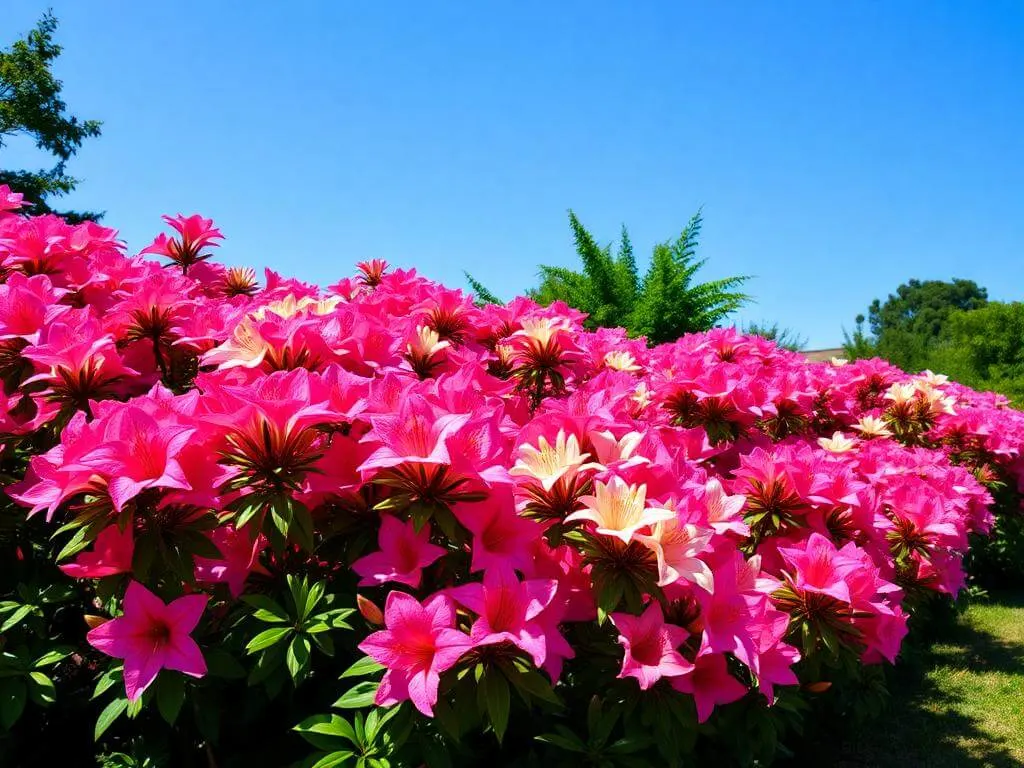
1. Why Azaleas Are Perfect for Landscaping
Azaleas are a top choice for gardeners and landscapers alike, offering a combination of aesthetic appeal, versatility, and ease of care. These flowering shrubs bring a unique charm to outdoor spaces, making them a staple in gardens worldwide. Let’s delve into the reasons why azaleas are an excellent choice for landscaping.
a. What Makes Azaleas Unique?
Azaleas are celebrated for their vibrant and abundant blooms, which come in a wide array of colors, including pink, red, white, purple, and orange. This diverse palette allows gardeners to create striking color combinations and add visual interest to any landscape. Additionally, azaleas are available in both evergreen and deciduous varieties, catering to different landscaping needs:
- Evergreen Azaleas provide year-round foliage, maintaining greenery even after the blooming season.
- Deciduous Azaleas offer seasonal interest with bright flowers in spring and stunning fall foliage.
b. Azaleas for All Seasons
One of the most remarkable features of azaleas is their ability to provide beauty throughout the year:
- Spring Blooms: Azaleas burst into a spectacular display of flowers, often becoming the focal point of any garden during spring.
- Fall Foliage: Certain deciduous varieties showcase vibrant red, orange, or yellow leaves in autumn.
- Year-Round Greenery: Evergreen varieties ensure that your garden remains lush and vibrant, even during the colder months.
This adaptability across seasons makes azaleas a timeless addition to any landscape.
c. Low-Maintenance Beauty
For gardeners looking for a balance between beauty and practicality, azaleas are a perfect fit. They require minimal maintenance to thrive, making them ideal for both beginners and seasoned landscapers. Key care benefits include:
- Minimal Pruning: Azaleas naturally maintain a compact and tidy growth habit, requiring only occasional pruning to shape or remove dead branches.
- Easy Watering Needs: Once established, azaleas need moderate watering and can adapt to most garden environments.
- Adaptability to Different Soils: With proper soil preparation—ideally acidic, well-drained soil—azaleas can flourish in a variety of landscapes.
d. Versatile Landscaping Options
Azaleas are incredibly versatile, suiting a range of garden styles and settings:
- Foundation Plantings: Their neat, rounded growth makes them excellent for planting near homes or buildings.
- Accent Plants: Use azaleas to highlight specific areas of your garden, such as focal points or entrances.
- Mass Plantings: Group azaleas together to create breathtaking displays of color in larger spaces.
Their ability to fit seamlessly into diverse garden designs makes them a go-to choice for anyone looking to enhance their outdoor space.
In summary, azaleas combine stunning aesthetics, seasonal adaptability, and low-maintenance care, making them an unparalleled choice for landscaping projects. Whether you want to brighten up a dull corner, add a pop of color to your pathways, or create a serene retreat, azaleas can do it all with ease and grace.
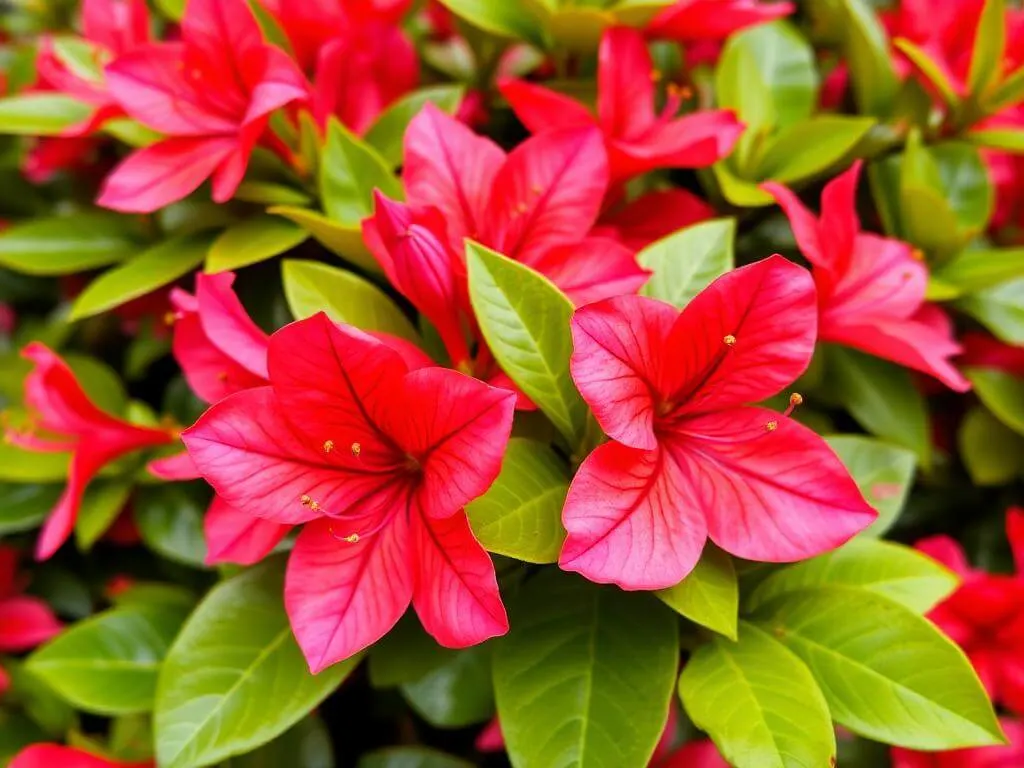
2. Designing Flower Beds and Borders with Azaleas
Azaleas are a perfect addition to flower beds and borders, thanks to their vibrant colors, variety of sizes, and elegant growth habits. Whether you’re designing a new garden or enhancing an existing one, azaleas can create stunning focal points and seamless transitions in your landscape. Here’s how to incorporate azaleas into your flower beds and borders effectively.
a. Ideal Placement in Flower Beds
Strategic placement is essential to make azaleas thrive and showcase their full beauty. Consider these tips when adding azaleas to your flower beds:
- Front-of-Bed Choices: Dwarf or compact azalea varieties, such as Kurume or Encore azaleas, are ideal for the front of flower beds. Their small stature ensures they won’t overshadow other plants.
- Back-of-Bed Selections: Taller varieties like deciduous azaleas can provide structure and height at the back of beds, creating a layered effect.
- Spacing and Grouping: Plant azaleas in clusters of three or more to achieve a natural, lush look while maintaining proper spacing for airflow and growth.
b. Mixed Borders for Year-Round Interest
Azaleas shine when paired with other plants to create diverse and visually appealing mixed borders. Here’s how to design borders with azaleas:
- Companion Plants: Pair azaleas with perennials like hostas, ferns, and daylilies for contrasting textures and continuous interest throughout the year.
- Seasonal Blooms: Include spring bulbs like daffodils and tulips to complement azalea flowers, or summer bloomers like hydrangeas for extended color.
- Evergreen Pairings: Combine evergreen azaleas with other evergreen shrubs, such as boxwoods or camellias, to maintain structure and greenery all year.
Mixed borders also help azaleas stand out by contrasting their blooms against different leaf shapes, sizes, and colors.
c. Color Coordination Ideas
Azaleas come in a wide range of hues, making them perfect for creating harmonious or dramatic color schemes in your garden. Here are some ideas:
- Monochromatic Schemes: Use azaleas in different shades of the same color, such as light pink, deep rose, and coral, for a soothing, cohesive look.
- Complementary Colors: Pair azaleas with flowers in complementary colors, like yellow daylilies or blue irises, to create eye-catching contrasts.
- Seasonal Themes: Design flower beds with seasonal themes—e.g., spring pastels with soft pink azaleas, or bold summer colors with bright red and orange blooms.
Experiment with color combinations to personalize your garden and highlight the vibrant blooms of azaleas.
d. Enhancing Edges and Pathways
Azaleas can also define and soften the edges of flower beds and borders:
- Soft Edges: Use low-growing varieties to create a natural and flowing edge along pathways or garden beds.
- Formal Borders: Plant azaleas in symmetrical rows for a more structured and polished appearance.
- Accent Walkways: Add azaleas near garden paths or stepping stones to draw attention and create a welcoming atmosphere.
By thoughtfully placing and pairing azaleas in your flower beds and borders, you can create dynamic, visually appealing spaces that showcase the shrubs’ natural beauty. Their adaptability and vibrant blooms make them an ideal centerpiece for any garden design.
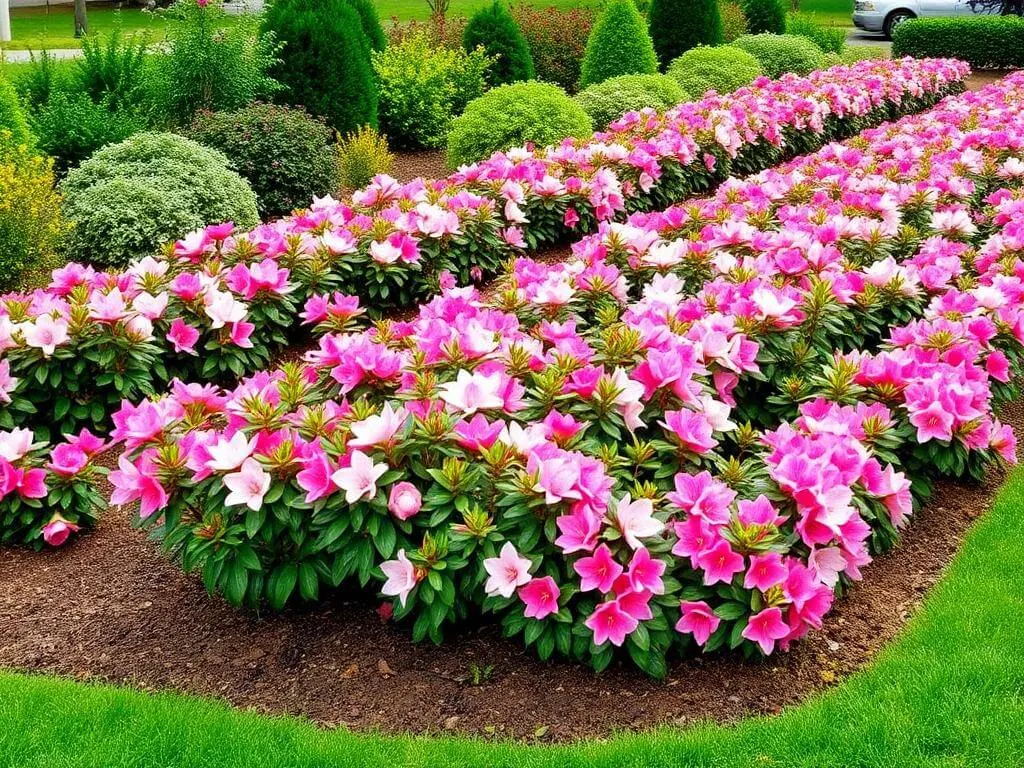
3. Enhancing Pathways and Walkways with Azaleas
Pathways and walkways are essential elements of any garden, providing structure, accessibility, and charm. Incorporating azaleas along these paths can elevate their visual appeal and create a seamless connection between different parts of your landscape. With their vibrant blooms, compact growth habits, and versatility, azaleas bring elegance and color to your garden’s pathways. Here’s how to use azaleas effectively to enhance walkways and paths.
a. Azaleas as Borders Along Walkways
Azaleas are perfect for lining pathways, creating soft, colorful edges that guide visitors through your garden.
- Compact Varieties for Neat Edges: Low-growing azaleas like Gumpo White or Hino Crimson are ideal for pathway borders, offering a tidy appearance without overpowering the path.
- Defining Curves: Use azaleas to highlight the curves of winding walkways, adding rhythm and flow to your garden design.
- Alternating Patterns: Plant azaleas in alternating colors or pair them with small, contrasting shrubs for a dynamic, visually appealing border.
b. Creating Natural Archways
Azaleas can also be used to frame pathways, creating natural archways or entrances that add a sense of enchantment and charm to your garden.
- Tall Azaleas for Vertical Interest: Plant taller azalea varieties like Southern Indica near arbors, trellises, or pergolas to create a lush, flower-filled canopy.
- Pairing with Climbers: Combine azaleas with climbing plants like wisteria or clematis for a layered, multi-dimensional effect.
- Framing Path Entrances: Position azaleas symmetrically at the start of a pathway to create a welcoming entrance and focal point.
c. Pathway Illumination with Blooms
Brightly colored azaleas can serve as natural “lighting” for pathways, especially in shaded or wooded gardens.
- Light-Colored Blooms: Use white, pale pink, or lavender azaleas to brighten darker areas and make walkways more inviting.
- Reflecting Natural Light: Plant azaleas near stones, gravel, or water features to reflect light and enhance their visual impact.
- Seasonal Glow: Choose azaleas with contrasting foliage, like evergreen varieties, to maintain interest even after the blooms fade.
d. Design Tips for Azaleas Along Pathways
- Spacing and Symmetry: Ensure proper spacing between plants for airflow and balanced growth. Symmetrical planting can add a formal, polished look.
- Mulching for Maintenance: Apply mulch around the base of azaleas to retain soil moisture and suppress weeds, keeping the area tidy and low maintenance.
- Complementing Hardscapes: Pair azaleas with stone, brick, or wood pathways for a harmonious blend of natural and constructed elements.
e. Blending Azaleas with Other Plants
To create even more visual interest along walkways, mix azaleas with companion plants:
- Ground Covers: Pair azaleas with creeping phlox or thyme for a colorful, textured base.
- Seasonal Flowers: Add bulbs like daffodils or tulips for early spring color before azaleas bloom.
- Ornamental Grasses: Incorporate grasses for contrast in height and texture, adding movement and softness to the walkway design.
By thoughtfully incorporating azaleas into pathways and walkways, you can transform these functional spaces into beautiful, engaging features. Their lush blooms, vibrant colors, and natural elegance will make every stroll through your garden a delightful experience.
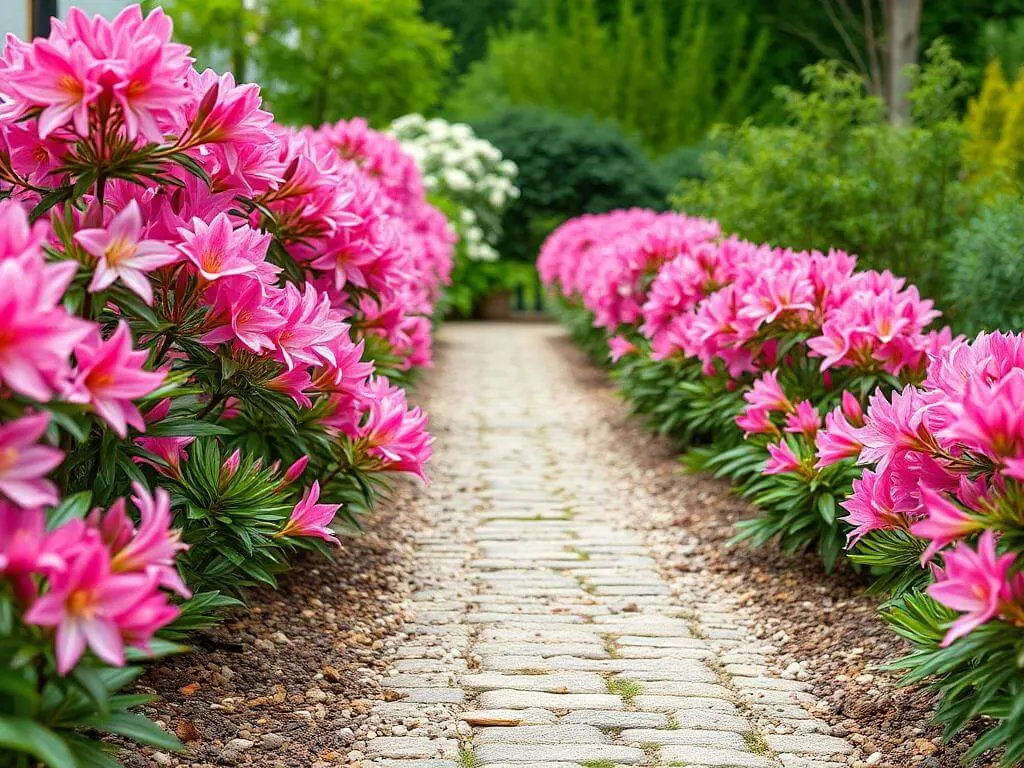
4. Using Azaleas in Woodland and Shade Gardens
Woodland and shade gardens provide a unique environment where azaleas can truly thrive, transforming these cool, shaded spaces into lush, vibrant retreats. With their preference for filtered light and acidic soil, azaleas are well-suited to the undercanopy of taller trees or shaded garden corners. Their vibrant blooms, combined with their ability to blend seamlessly into woodland settings, make them a must-have for creating naturalistic, serene gardens. Here’s how to use azaleas effectively in woodland and shade gardens.
a. Why Azaleas Thrive in Woodland Settings
Azaleas naturally grow in woodland environments, making them an excellent choice for shady or partially shaded areas in your garden. These shrubs are adapted to thrive in the dappled sunlight found under the canopy of trees, where they enjoy cool, moist conditions and rich, acidic soil. The key factors contributing to azaleas’ success in these settings include:
- Filtered Light: Azaleas do not need direct sunlight to flourish and, in fact, prefer the soft, filtered light that comes through tree canopies or structures like pergolas.
- Moist, Well-Drained Soil: Azaleas favor slightly acidic, humus-rich soil, which is often found in woodland settings, where decaying organic material provides excellent soil quality.
- Cooler Microclimates: The canopy of surrounding trees helps protect azaleas from harsh summer sun, ensuring that the roots stay cool and moist, preventing them from drying out.
By planting azaleas in the right spot within your woodland or shade garden, they will adapt to these conditions and thrive, offering beautiful blooms year after year.
b. Layered Planting Techniques
Azaleas can be a key part of a layered planting strategy in your woodland garden. This design approach mimics the natural layering found in forests, where plants grow at different heights and levels. Using this technique not only helps integrate azaleas into the garden’s structure but also maximizes visual interest by combining different plant species with complementary textures and colors.
- Under-Tree Layer: Plant azaleas in the shaded areas beneath trees to mimic the natural understory of a forest. Combine them with ferns, hostas, and other shade-loving plants for a soft, flowing effect.
- Middle Layer: Consider using medium-sized azaleas in areas where taller shrubs or trees are present. These can form a mid-level layer that adds depth and variety to your woodland garden.
- Foreground Layer: For smaller azalea varieties, position them in the front of garden beds or pathways. Their vibrant blooms can highlight the other plants around them and provide a stunning contrast to the darker backdrop.
c. Creating a Tranquil Retreat
Woodland gardens with azaleas provide a peaceful, tranquil environment perfect for relaxation and reflection. By thoughtfully integrating azaleas into the landscape, you can create a serene and harmonious space that feels like a private garden oasis. Here’s how to make the most of azaleas in a tranquil woodland setting:
- Naturalistic Planting: Plant azaleas in irregular groups rather than in neat rows for a more natural, flowing appearance. This mimics the way plants grow in the wild and creates a relaxed atmosphere.
- Color Harmony: Choose azaleas in soft, calming colors like pale pink, lavender, or white to blend with the peaceful, shaded environment. These hues evoke a sense of tranquility and complement the cool tones of the woodland.
- Incorporate Water Features: Add a small pond, stream, or birdbath nearby to enhance the peaceful ambiance. The presence of azaleas combined with the sound of water creates a soothing, serene garden retreat.
d. Choosing the Right Azalea Varieties for Shade
Not all azaleas are equally suited for shade, so selecting the right varieties is key to ensuring their success in your woodland or shaded garden. Some varieties are more tolerant of shade, while others prefer more sun exposure. Consider the following types for optimal performance in shady settings:
- Indica Azaleas: These evergreen azaleas are well-suited for shaded areas and have large, showy blooms in a range of colors, from pinks and reds to whites and purples.
- Deciduous Azaleas: Varieties like Exbury or Knaphill azaleas are excellent choices for woodland settings, offering vibrant flowers in the spring and stunning fall foliage in shades of red, orange, and yellow.
- Kurume Azaleas: These compact, evergreen varieties thrive in partial shade and are perfect for smaller woodland gardens or as ground covers.
e. Combining Azaleas with Other Woodland Plants
Azaleas are not just stunning on their own—they also pair beautifully with other woodland plants to create a balanced, harmonious landscape. Some great companion plants to use with azaleas include:
- Ferns: Their delicate fronds provide texture and contrast to the broad leaves of azaleas, creating a soft, lush feel in the garden.
- Hostas: Hostas offer shade-loving foliage in a variety of textures and colors, making them perfect companions to azaleas. The contrast between the two creates visual interest.
- Trilliums and Epimediums: These perennial plants add seasonal blooms and ground cover to complement the structure provided by azaleas. Their subtle flowers and foliage work well with azalea blooms.
- Lungwort and Solomon’s Seal: These plants thrive in similar conditions to azaleas and can fill in the spaces between azaleas, providing foliage that contrasts with the azaleas’ flowers.
Incorporating azaleas into your woodland and shade gardens creates a dynamic and peaceful environment that feels effortlessly lush and natural. With their ability to thrive in shaded conditions, vibrant flowers, and versatile forms, azaleas are the perfect choice for adding both color and structure to your shaded outdoor spaces. By pairing them with complementary plants, utilizing layered designs, and selecting the right varieties, you can craft a woodland garden that feels like a serene escape all year long.
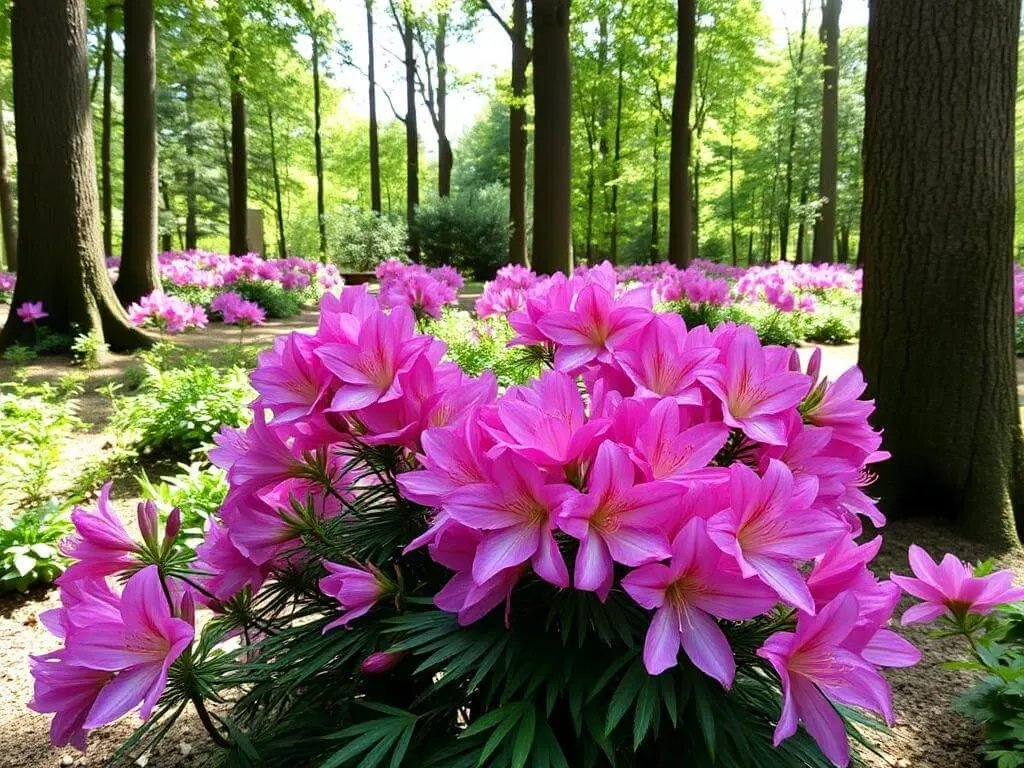
5. Adding Structure with Hedges and Privacy Screens Using Azaleas
Azaleas are not only valued for their stunning flowers but also for their ability to create structure and define spaces within a garden. Their dense growth and versatility make them an excellent choice for hedges and privacy screens, offering both functional and aesthetic benefits. Whether you’re looking to define garden boundaries, create intimate outdoor rooms, or block unsightly views, azaleas can be shaped and maintained to provide beautiful, living partitions that enhance your landscape. Here’s how you can use azaleas to add structure through hedges and privacy screens.
a. Creating Formal Hedges with Azaleas
Azaleas can be cultivated into formal hedges that provide neat, well-defined boundaries for garden spaces, paths, or patios. The dense foliage and vibrant blooms create a natural partition while contributing to the garden’s aesthetic appeal.
- Choosing the Right Varieties: For a neat, formal hedge, select azaleas that naturally grow dense and compact, such as Encore Azaleas or Kurume Azaleas. These varieties can be trimmed into uniform shapes while maintaining their lush foliage and vibrant flowers.
- Planting for Density: When planting azaleas for a hedge, ensure that they are spaced closely enough to form a thick, continuous screen. Typically, spacing them about 2-3 feet apart will allow them to grow together and fill in over time.
- Regular Pruning: Azaleas can be pruned and shaped regularly to maintain a formal, tidy look. While azaleas naturally have a rounded form, they respond well to light pruning, which will encourage new growth and keep the hedge dense. Trim back after flowering to maintain their shape and avoid cutting into old wood, which could reduce future blooms.
By maintaining a formal azalea hedge, you can define different garden areas, frame outdoor spaces, or even hide unsightly structures like fences or garden sheds.
b. Using Azaleas as Informal Privacy Screens
Azaleas also make excellent informal privacy screens in areas where you want to create a sense of seclusion without the rigid appearance of a traditional fence. Their dense, bushy growth creates a natural barrier while adding beauty and color to your garden.
- Relaxed, Natural Look: For a less structured, more organic look, use larger varieties of azaleas, such as Southern Indica or Exbury Azaleas, which naturally grow in a looser form. These varieties will create a more natural, flowing screen that blends into the landscape.
- Layering for Depth: To enhance the depth and visual interest of a privacy screen, consider layering azaleas of different heights. Place taller varieties in the back and smaller, compact ones in the front for a gradual transition.
- Combination with Other Shrubs: Azaleas can be paired with other shrubs like holly, viburnum, or boxwood to create a thicker, more robust screen. This can help increase the overall height and density of the screen while adding variety to the texture and color palette.
Azaleas used in this way can shield you from neighbors, traffic, or undesirable views, while still maintaining a soft, aesthetically pleasing garden atmosphere.
c. Incorporating Azaleas in Garden Dividers
Azaleas can be employed as garden dividers to break up large outdoor spaces into smaller, more intimate sections. These dividers can help create a sense of privacy, promote conversation areas, and guide movement within the garden.
- Defining Outdoor Rooms: Use azaleas to separate different areas of your garden, such as a dining space from a lounging area or a vegetable garden from ornamental plantings. Their colorful blooms and lush foliage help delineate areas without making the space feel closed off.
- Enhancing Pathways and Borders: Azaleas can serve as living dividers along garden pathways or at the edges of patios. Whether planted in clusters or trimmed into low hedges, azaleas guide the eye and add definition to the landscape.
- Creating Enclosed Spaces: For a more private feel, azaleas can be planted in a more solid line to form a barrier that gives the impression of a secluded outdoor “room.” This is especially effective in larger gardens where creating small, intimate spaces is key to maximizing enjoyment and functionality.
Using azaleas to create garden dividers helps to establish order in the landscape and creates a more intimate environment for relaxation or socializing.
d. Enhancing the Aesthetic Appeal of Hedges and Screens
Azaleas not only serve practical purposes but also add beauty to your garden, making them an attractive option for hedges and privacy screens. Here are some ways to enhance the aesthetic appeal of your azalea hedges and screens:
- Seasonal Color: Azaleas bloom in a wide range of vibrant colors, from soft pastels to bold reds, pinks, and purples. Planting varieties that bloom at different times can provide color throughout the year, enhancing the visual interest of your hedge or screen.
- Foliage Texture: In addition to their flowers, azaleas have glossy, leathery leaves that provide texture and structure to your hedge or screen. Evergreen azaleas offer year-round foliage, providing a consistent, dense backdrop even in the winter months.
- Framing with Azaleas: Azaleas can also be used as framing plants around the edges of patios, porches, or gazebos, adding both structure and a splash of color to these focal points. Consider planting azaleas in staggered layers or using them to complement the natural contours of your garden.
By thoughtfully incorporating azaleas into your garden design, you can create beautiful and functional privacy screens and hedges that serve multiple purposes while enhancing the overall aesthetic of your landscape.
e. Maintaining Healthy and Long-Lasting Azalea Hedges and Screens
To ensure your azaleas continue to thrive as hedges and privacy screens, proper care and maintenance are essential:
- Watering and Mulching: Azaleas need consistent moisture, especially during dry spells. Water them deeply and apply mulch around the base to retain moisture and prevent weeds.
- Soil Quality: Azaleas prefer acidic, well-drained soil. Ensure that the soil in your garden is suitable for azaleas, and amend it with organic matter if necessary.
- Fertilization: Fertilize azaleas with a balanced, slow-release fertilizer that is specifically formulated for acid-loving plants. Avoid over-fertilizing, as this can damage the roots and result in poor growth.
By providing the right care, your azalea hedges and privacy screens will remain healthy and beautiful for years to come, continuously adding value to your garden space.
Azaleas offer a natural, colorful way to create structure and privacy in your garden. Whether you’re aiming for formal hedges, informal privacy screens, or elegant garden dividers, these versatile shrubs provide a visually appealing solution that can transform your landscape. With the right selection, placement, and care, azaleas will not only enhance your garden’s functionality but also contribute to its beauty and charm.
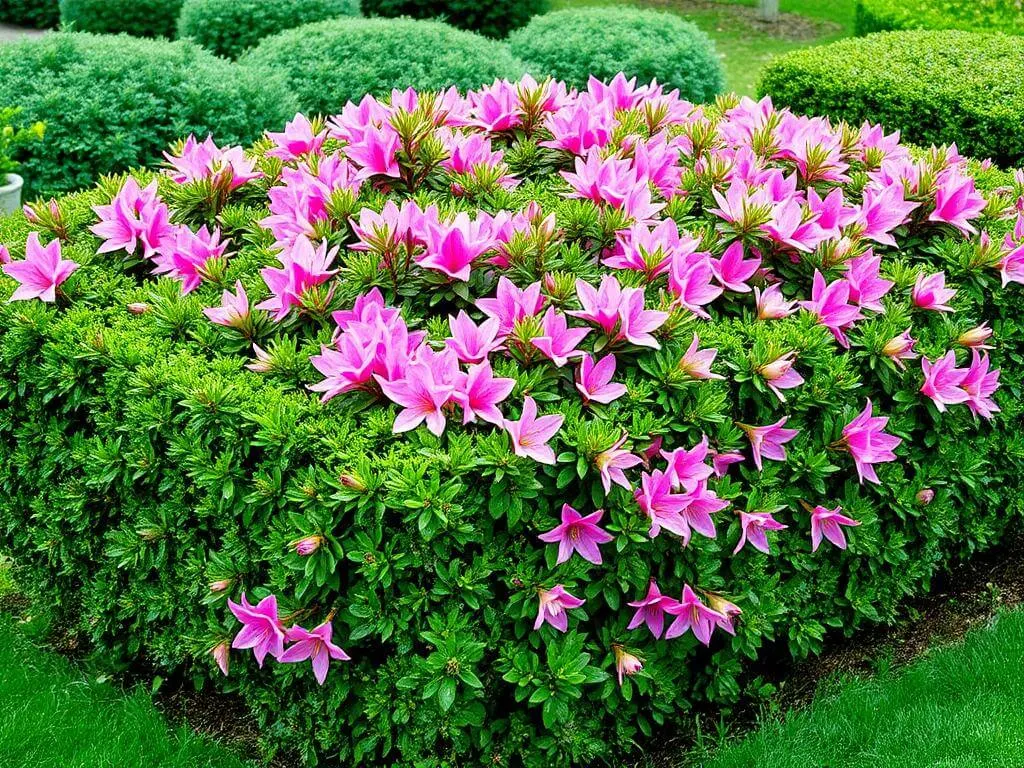
6. Elevating Small Spaces with Azaleas in Containers
For those with limited space or urban dwellers looking to bring nature into their environment, azaleas in containers offer a versatile and effective solution. Whether on a balcony, rooftop, patio, or small garden, azaleas can transform tight spaces into lush, vibrant areas of interest. Container gardening allows you to control the growing conditions of azaleas, making it possible to cultivate them even in spaces with less-than-ideal soil. Here’s how to elevate small spaces with azaleas in containers and maximize their beauty and impact.
a. Choosing the Right Azalea Varieties for Containers
Not all azalea varieties are suitable for container gardening, so selecting the right type is essential for ensuring success in small spaces. When growing azaleas in containers, consider the following varieties known for their compact growth and suitability for confined spaces:
- Encore Azaleas: These compact, evergreen azaleas are well-suited for containers due to their manageable size and repeat blooming cycle throughout the year. With a variety of colors available, Encore Azaleas can add continuous beauty to any space.
- Kurume Azaleas: Known for their smaller, dense form, Kurume azaleas are perfect for container gardening. These varieties stay compact and produce abundant blooms in spring, making them an excellent choice for patios or balcony gardens.
- Ballerina Azaleas: These petite varieties grow to a manageable size, with soft, colorful flowers that make them an ideal choice for window boxes, small pots, or hanging baskets.
- Satsuki Azaleas: Another excellent option for containers, Satsuki azaleas are smaller, deciduous varieties that produce striking blooms in late spring to early summer, adding color to smaller outdoor spaces.
By choosing the right azalea variety, you ensure that your container garden is not overcrowded, allowing the plants to thrive and bloom beautifully in small spaces.
b. Maximizing Space with Container Grouping
One of the benefits of container gardening is the ability to group multiple plants together in one area, creating a dynamic display without requiring large amounts of space. Azaleas, when grouped with complementary plants, can create a lush, layered look in tight areas. Here are a few strategies to maximize the impact of your azaleas in containers:
- Mixing Azaleas with Other Small Shrubs: Combine azaleas with other compact plants, such as dwarf evergreens, heuchera, or ferns, to create a multi-layered, textured display. This adds interest and dimension while making full use of your container space.
- Consider Seasonal Combinations: Group azaleas with plants that bloom at different times of the year, creating year-round visual appeal. Pairing azaleas with spring-blooming perennials or summer-blooming plants can keep the container looking vibrant throughout the seasons.
- Layering in Tall Containers: For a vertical approach, use taller containers and layer azaleas with other plants that grow at different heights. You could plant shorter flowers or ground covers in the front, allowing the azaleas to rise behind them, creating a lush backdrop.
This grouping strategy allows azaleas to become a focal point while maximizing limited space in your small garden, patio, or balcony.
c. Creating a Colorful Focal Point
Azaleas, known for their vibrant and varied blooms, can instantly become a colorful focal point in a small space. With the right placement and selection, they can anchor your design and add an eye-catching display to your outdoor area. Consider the following tips to elevate the visual impact of your azaleas in containers:
- Bold, Vibrant Colors: Azaleas come in a wide array of colors, from bright pinks and reds to softer pastels and white. Choose bold colors to create a statement or select softer tones for a more tranquil, serene effect.
- Contrast and Coordination: To make your azalea stand out, pair it with plants that provide contrast in color, texture, and shape. For instance, use darker-leaved plants or silver foliage to make the bright azalea blooms pop. Alternatively, create a more harmonious look by grouping azaleas with plants in complementary colors like soft lavender, pale yellow, or cool blues.
- Vertical Impact: Place azaleas in elevated containers, such as hanging baskets or tall planters, to draw the eye upward and create visual interest. This works especially well in small patios or balconies where floor space is limited but vertical space can be maximized.
Azaleas in containers provide an opportunity to introduce color and vibrancy into smaller spaces, serving as the perfect focal point for outdoor areas.
d. Container Placement and Sunlight Considerations
While azaleas thrive in well-drained, acidic soil, they also require adequate sunlight to bloom at their best. In small spaces, where light conditions may vary, it’s essential to place your azalea containers strategically to meet their needs. Consider these placement tips for optimal growth:
- Partial Shade to Full Sun: Most azaleas prefer partial shade, especially in areas with intense midday sun. However, some varieties, like Encore Azaleas, can tolerate more direct sunlight. Place your containers where they will receive morning sun and afternoon shade, particularly in hot climates, to protect the plants from scorching.
- Avoid Hot, Dry Locations: While azaleas enjoy warmth, it’s important to avoid placing containers in spots where the sun will dry out the soil quickly, such as directly against a hot wall or in a dry corner. Ensure that your containers are in a location that provides light but not excessive heat.
- Mobility of Containers: One of the benefits of container gardening is the ability to move plants around. Take advantage of this by relocating your azaleas throughout the season to follow the optimal sunlight conditions. If you notice that they’re not blooming as expected, adjust their position slightly for more or less light.
By placing azaleas in the right spots with the appropriate light exposure, you’ll ensure they have the best growing conditions and produce beautiful blooms, enhancing your small space.
e. Caring for Azaleas in Containers
Azaleas in containers may require slightly more attention than those planted in the ground, but with proper care, they can thrive and continue to enhance your space year after year. Key aspects of care include:
- Watering: Azaleas in containers need consistent moisture, especially during warm weather. Make sure the soil remains evenly moist but not soggy, and ensure your containers have proper drainage to prevent waterlogging.
- Fertilization: Use a slow-release fertilizer formulated for acid-loving plants, as azaleas prefer slightly acidic soil. Fertilize in early spring before the bloom period and again after flowering to encourage strong growth.
- Repotting: Azaleas in containers may outgrow their pots over time. Repot them every 2-3 years to refresh the soil and provide room for growth. Be sure to use fresh, well-draining, acidic soil to maintain healthy conditions.
- Pruning and Deadheading: After blooming, trim spent flowers and any dead or damaged growth to maintain the plant’s shape and encourage new blooms. Avoid heavy pruning in early spring, as azaleas bloom on old wood.
Proper care will ensure that your azaleas continue to thrive in containers, providing stunning color and structure to your small spaces for years to come.
f. Creative Container Ideas for Small Spaces
Container gardening allows for a great deal of creativity, particularly in small spaces. Azaleas can be placed in a variety of unique containers and displayed in imaginative ways to enhance the look of your space:
- Hanging Baskets and Wall Planters: Use hanging baskets or wall-mounted planters to elevate your azaleas, creating a cascading display of color. These work especially well in narrow spaces like balconies or small patios.
- Decorative Pots and Urns: Choose stylish, decorative pots or urns to complement your existing garden décor. Choose materials like terracotta, ceramic, or concrete for a timeless look that pairs well with azaleas.
- Repurposed Containers: Get creative by using repurposed or upcycled items such as wooden crates, old watering cans, or rustic barrels as containers for your azaleas. These quirky containers add personality and charm to your space while still providing a functional planting option.
By exploring different container options and placements, you can add a unique touch to your small outdoor spaces, all while showcasing the beauty of azaleas in their full bloom.
Azaleas in containers offer an excellent solution for elevating small spaces, turning balconies, patios, and courtyards into vibrant, stylish retreats. With the right variety, placement, and care, azaleas can thrive in containers and provide year-round beauty and structure, even in the most confined spaces. Whether used as focal points, groupings, or colorful accents, azaleas in containers can transform any small area into a garden oasis.

Conclusion: Embracing the Beauty and Versatility of Azaleas in Your Landscape
In conclusion, azaleas are not only stunning flowering plants but also incredibly versatile when it comes to enhancing your landscape. Their adaptability to various settings—from lush garden beds and shady woodlands to vibrant container displays—makes them a perfect choice for any outdoor space. Whether you have a sprawling garden or a small patio, azaleas can be strategically placed to add color, texture, and structure.
Throughout this guide, we’ve explored the many creative landscape uses for azaleas. From their ability to transform flower beds and borders to their role in defining pathways, hedges, and privacy screens, azaleas offer endless possibilities for designing beautiful and functional outdoor spaces. Their easy maintenance and stunning seasonal blooms ensure that your garden remains captivating throughout the year.
Moreover, azaleas’ capacity to thrive in containers opens up even more options for those working with limited space. By carefully selecting the right varieties, pairing them with complementary plants, and ensuring proper care, azaleas can elevate even the smallest of gardens, patios, or balconies. Their versatility in both large and compact landscapes makes them an essential plant for anyone looking to create an inviting, beautiful outdoor environment.
As you plan your landscape design, consider incorporating azaleas into your vision. With their stunning blooms, unique textures, and ability to thrive in different environments, azaleas can transform your garden into a sanctuary of color and tranquility. Whether used as a focal point, a border, or a privacy screen, azaleas will undoubtedly add beauty and elegance to your landscape, turning it into a true reflection of your creativity and love for nature.
By embracing the beauty and versatility of azaleas, you can create a landscape that is not only visually striking but also a testament to the power of thoughtful, nature-inspired design. Take inspiration from the many ways azaleas can be used, and watch your garden come to life with these delightful, vibrant plants.
